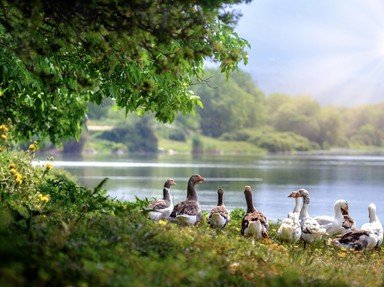Quiz Answer Key and Fun Facts
1. The Passer domesticus is a small greyish-brownish bird, usually living in the immediate vicinity of human habitations. What is its common English name?
2. The Turdus merula is about 25 to 29 cm long, and the male has only one colour in its plumage: it is entirely black. He has, however, a bright orange beak. The female and the young birds are brownish, the young ones usually with some specks. What name is given to this bird, mainly because of its appearance?
3. The next bird is known under the scientific name Pyrrhula pyrrhula. It's about 16 cm tall. The male has a black cap and face, greyish back and black wings with a white or grey stripe. The chest and lower body parts are bright orange to pink. Females have dull grey instead of bright orange-pink. What is the common name of this bird?
4. The Parus major is the largest of its family, although the family comprises fairly small birds. The Parus major is about 14 cm tall. It has a black crest, white cheeks and yellow plumage at the chest and belly. The wings are green to blue-grey. What is the common name for this bird?
5. We move on to a bird of about 50 cm tall, greyish with a black cap and black wings. Its scientific name is the Corvus cornix, but what is its English name?
6. The bird we're looking for in this question is not sitting in a pear tree. Which brownish-greyish game bird, known to the scientists as the Perdix perdix, lives mostly on the ground near cereal fields?
7. The Erithacus rubecula is a rather small bird (about 12 to 14 cm long). Characteristic for this bird is a red to orange chest. What is its common English name?
8. The Troglodytes troglodytes is a small bird, about 9 to 10 cm long. Its plumage is brown-grey. What is the common name of this small bird?
9. The Garrulus glandarius is one of the most colourful birds in Europe. A brown to pink body with white blazes is combined with a black tail and blue - grey stripes on the wings. What is the common name for the Garrulus glandarius?
10. The next bird is known to taxonomists as Oriolus oriolus. The male is yellow and black, with black wings, the female is a bit duller in colour. What is its common name?
Source: Author
JanIQ
This quiz was reviewed by FunTrivia editor
guitargoddess before going online.
Any errors found in FunTrivia content are routinely corrected through our feedback system.

